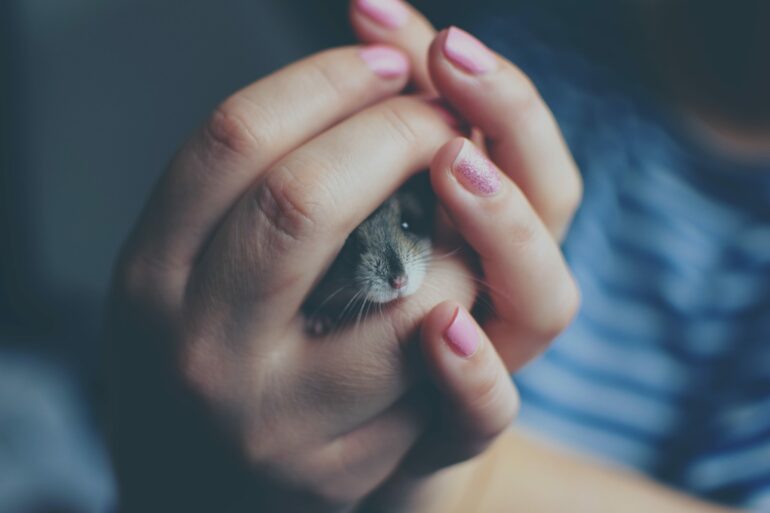Hamsters are naturally clean animals who do a terrific job of bathing themselves. Although some hamsters may need a little help along the way to ensure they’re healthy and clean, they typically don’t need full baths like dogs do.
But notice that we said typically. As a pet owner, you’re likely aware that things don’t always go 100% according to plan.
So, it’s no surprise you’re wondering how to keep your hamster clean—both day-to-day and in the event something unexpected happens. Keep reading for answers to all of your questions regarding how to clean a hamster!
Can You Clean a Hamster?
Yes, you can clean a hamster, though the process is different than what you might expect. You see, hamsters’ skin and fur are both coated in natural oils produced by their bodies. These oils are necessary for their overall health and well-being.
You should also know that in the wild, a hamster’s natural habitat tends to be sandy, dry parts of the world. Hamsters just aren’t familiar with—or equipped for—the same kind of bath you’d give a dog.
So, whenever you clean a hamster, you’re not going to be giving it a bath unless your vet specifically instructs you to, which we’ll talk about more a bit later in this article. Instead, you’ll be using methods that include little to no water.
What Can You Use To Clean a Hamster?
You can use several different methods to clean a hamster, such as:
- Hamster bathing sand, the ideal choice for a standard hamster bath. Because these critters naturally live in dry, desert-like environments, they don’t benefit from a soak in the tub. Hamsters prefer having a little sandbox in their cage for keeping clean—and it almost always works just as well as a wet bath.
- Small grooming brush, whenever your hamster’s fur is caked in something sticky or toxic. You don’t want to stress your hamster out by using this often, but having it is good peace of mind for those urgent or emergency moments.
- Hamster shampoo, for the rare occasions when water and brushing aren’t enough. While shopping for hamster-friendly shampoo, look for something that’s unscented and extremely mild. This option is great because it’s no-rinse, meaning it simply wipes away—no need for a sudsy, hamster bath.
How Often Should You Clean a Hamster?
You should only clean a hamster as often as it’s obviously needed. No matter the method—whether a damp cloth or a full bath—you should only do it when your hamster’s health is immediately at risk. This again is due to your hamster’s natural instincts and habits in the wild.
But when it comes to letting your hamster give itself a sand bath, you have more freedom. You can add a sandbox with sand no more than one-inch deep to their cage permanently or place it inside their cage a few times a week.
Just remember to check the sandbox daily if you leave it in your hamster’s cage permanently, because they may start using it as a bathroom.
How To Clean a Hamster
Do not immerse your hamster in water! Doing this can cause harm to their skin and fur by stripping away necessary, natural oils covering their body. They can also catch colds extremely easily and can become sick or stressed after being in water.
Only give them a full bath if a qualified, exotic animal veterinarian recommends it due to a serious health condition or circumstance.
If your hamster has dirty fur or is producing strong smells even after a sand bath, they may need a bit of help with their hygiene. The best way to clean a hamster in this case is using a small brush to work the sand through your hamster’s fur. This process helps remove dirt and debris, and can be especially great for pulling out knots or dried dirt from places your hamster can’t easily reach.
Keep this in mind if you happen to adopt one of the few hamsters who doesn’t care much about personal cleanliness. It’s also helpful with older or injured hamsters who can’t clean themselves as well as they once could.
How To Give a Hamster a Bath (Only When Necessary)
This should be your absolute last resort for cleaning a hamster. A wet bath may be needed if a sticky or toxic substance has become stuck in your hamster’s fur, which puts the animal in danger.
Ideally, you should get an exotic vet’s permission and guidance before attempting a hamster bath. But there are certain emergency situations where you don’t have time to consult with one.
The safest way to bathe a hamster is by using a damp toothbrush or cloth to rub the hamster’s fur and gently remove the substance. Use as little water as possible throughout this entire process.
If you absolutely must give your hamster a full bath—which again, should only be done to save their life and with approval from an exotic vet—you can fill a bowl with a maximum of one-half inch of lukewarm water. Very gently bathe your hamster. You can use a toothbrush as described above in this scenario, too.
But no matter what, you must ensure that absolutely no water gets in your hamster’s eyes or on their face.
Because hamsters’ natural habitats are dry, arid areas, they simply have no idea how to swim or stay safe in water. Trying to bathe a hamster can cause fatal levels of stress, so you have to take the utmost care.
Once done, very gently place your hamster on a dry towel. Use the other end or another towel to carefully pat your hamster dry. Then, let your furry friend finish drying in a warm and calm environment before returning them to their home.
Clean Home, Happy Hamster
The easiest way to keep your hamster clean is by taking the time to keep their living spaces hygienic. This is a very effective way to ensure your pet doesn’t smell and lives a happy, healthy life.
You’ll want to clean their bathroom area daily to keep out odors, minimize bacteria and encourage them to continue using the same place for their potty. Your hamster’s water bottle, food dish, bedding and cage should each be cleaned weekly or once excessively dirty—whichever comes first.
So long as you stay on top of frequent cleaning and provide sand bath opportunities like your hamster would find in their natural habitat, you should rarely (if ever) need to provide a wet and soapy hamster bath.




